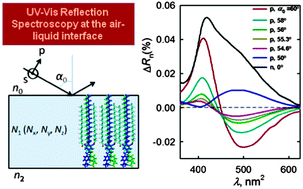UV-Vis reflection spectroscopy under variable angle incidence at the air–liquid interface
Abstract
The UV-Vis reflection spectroscopy (UV-Vis-RS) in situ at the air–liquid interface provides information about tilt and aggregation of chromophores in Langmuir monolayers. This information is particularly important given in most cases the chromophore is located at the polar region of the Langmuir monolayer. This region of the Langmuir monolayers has been hardly accessible by other experimental techniques. In spite of its enormous potential, the application of UV-Vis-RS has been limited mainly to reflection measurements under light normal incidence or at lower incidence angles than the Brewster angle. Remarkably, this technique is quite sensitive to the tilt of the chromophores at values of incidence angles close to or larger than the Brewster angle. Therefore, a novel method to obtain the order parameter of the chromophores at the air–liquid interface by using s- and p-polarized radiation at different incidence angles is proposed. This method allowed for the first time the experimental observation of the two components with different polarization properties of a single UV-Vis band at the air–liquid interface. The method of UV-Vis spectroscopy under variable angle incidence is presented as a new tool for obtaining rich detailed information on Langmuir monolayers.


 Please wait while we load your content...
Please wait while we load your content...